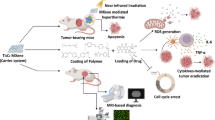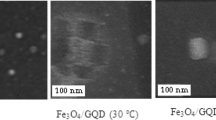Abstract
MXene has become one of the most sought-after 2D materials with incredible potential in various fields. This work reports the use of a cationic polymer polyethyleneimine (PEI) to generate a positive charge on the MXene surface. PEI is a positively charged polymer containing repeating amine groups. PEI functionalized MXene nanoflakes (PEI_Ti3C2) were produced by etching Ti3AlC2, followed by ultrasonication along with PEI, and then hydrothermally treated at 200 °C for 24 h. The as-obtained nanosheets were characterized through XRD, AFM, TEM, UV–Vis spectroscopy, PL, and FTIR. The thickness of PEI_Ti3C2 was found to be 2.6 ± 0.8 nm compared to control (h-Ti3C2) which exhibited 6.8 ± 1.6 nm height, proving utilization of PEI both as a surfactant as well as a functionalizing agent. The surface charge of PEI_Ti3C2 sheets was observed to be 15.57 ± 2.76 mV due to the presence of imine groups. Colloidal solution of PEI_Ti3C2 displayed high absorption in both the UV (315–600 nm) and NIR ranges (880–996 nm) as well as exhibits blue fluorescence. The use of the PEI polymer also assists in MXene forming a stable aqueous dispersion. PEI_Ti3C2 showed high biocompatibility in mouse fibroblast and red blood cells. On the other hand, the nanosheets demonstrated concentration-dependent cellular toxicity on cancer cells when irradiated with 808 nm laser irradiation for 10 min. The small-sized PEI_Ti3C2 are highly scalable, reproducible, biocompatible, possess intrinsic NIR activity, fluorescence, and cationic character. The NIR activity and photoluminescence of the 2D nanosheets make them multifaceted to be utilized as cell labeling probes, sensors, and photothermal therapy.





Similar content being viewed by others
References
Naguib M, Kurtoglu M, Presser V et al (2011) Two-dimensional nanocrystals produced by exfoliation of Ti3AlC2. Adv Mater 23:4248–4253. https://doi.org/10.1002/adma.201102306
Alhabeb M, Maleski K, Anasori B et al (2017) Guidelines for synthesis and processing of two-dimensional titanium carbide (Ti3C2Tx MXene). Chem Mater 29:7633–7644. https://doi.org/10.1021/acs.chemmater.7b02847
Chen K, Qiu N, Deng Q et al (2017) Cytocompatibility of Ti3AlC2, Ti3SiC2, and Ti2AlN. In vitro tests and first-principles calculations. ACS Biomater Sci Eng 3:2293–2301. https://doi.org/10.1021/ACSBIOMATERIALS.7B00432
Gogotsi Y, Anasori B (2019) The rise of MXenes. ACS Nano 13:8491–8494
Xin M, Li J, Ma Z et al (2020) MXenes and their applications in wearable sensors. Front Chem 8:297
Dai C, Lin H, Xu G et al (2017) Biocompatible 2D titanium carbide (MXenes) composite nanosheets for pH-responsive MRI-guided tumor hyperthermia. Chem Mater 29:8637–8652. https://doi.org/10.1021/acs.chemmater.7b02441
Guan Q, Ma J, Yang W et al (2019) Highly fluorescent Ti3C2 MXene quantum dots for macrophage labeling and Cu2+ ion sensing. Nanoscale 11:14123–14133. https://doi.org/10.1039/c9nr04421c
Singh B, Bahadur R, Neekhra S et al (2021) Hydrothermal-assisted synthesis and stability of multifunctional mxene nanobipyramids: Structural, chemical, and optical evolution. ACS Appl Mater Interfaces 13:3011–3023. https://doi.org/10.1021/acsami.0c18712
Cai G, Yu Z, Tong P, Tang D (2019) Ti3C2 MXene quantum dot-encapsulated liposomes for photothermal immunoassays using a portable near-infrared imaging camera on a smartphone. Nanoscale 11:15659–15667. https://doi.org/10.1039/c9nr05797h
George SM, Kandasubramanian B (2020) Advancements in MXene-polymer composites for various biomedical applications. Ceram Int 46:8522–8535
Sun B, Lv H, Liu Z et al (2021) CO3O4 @PEI/Ti3C2Tx MXene nanocomposites for a highly sensitive NOx gas sensor with a low detection limit. J Mater Chem A 9:6335–6344. https://doi.org/10.1039/d0ta11392a
Li K, Jiao T, Xing R et al (2018) Fabrication of hierarchical MXene-based AuNPs-containing core–shell nanocomposites for high efficient catalysts. Green Energy Environ 3:147–155. https://doi.org/10.1016/j.gee.2017.11.004
Tian Y, Yang C, Que W et al (2017) Ni foam supported quasi-core-shell structure of ultrathin Ti3C2 nanosheets through electrostatic layer-by-layer self-assembly as high rate-performance electrodes of supercapacitors. J Power Sources 369:78–86. https://doi.org/10.1016/j.jpowsour.2017.09.085
Jimmy J, Kandasubramanian B (2020) Mxene functionalized polymer composites: Synthesis and applications. Eur Polym J 122:109367
Fan X, Liu L, Jin X et al (2019) MXene Ti3C2Tx for phase change composite with superior photothermal storage capability. J Mater Chem A 7:14319–14327. https://doi.org/10.1039/c9ta03962g
Tian W, VahidMohammadi A, Wang Z et al (2019) Layer-by-layer self-assembly of pillared two-dimensional multilayers. Nat Commun 10:1–10. https://doi.org/10.1038/s41467-019-10631-0
Chen Z, Lv Z, Sun Y et al (2020) Recent advancements in polyethyleneimine-based materials and their biomedical, biotechnology, and biomaterial applications. J Mater Chem B 8:2951–2973
Wang F, Liu P, Nie T et al (2013) Characterization of a polyamine microsphere and its adsorption for protein. Int J Mol Sci 14:17–29. https://doi.org/10.3390/ijms14010017
Ihm JE, Krier I, Lim JM et al (2015) Improved biocompatibility of polyethylenimine (PEI) as a gene carrier by conjugating urocanic acid: in vitro and in vivo. Macromol Res 23:387–395. https://doi.org/10.1007/s13233-015-3047-8
Cho TJ, Gorham JM, Pettibone JM et al (2019) Parallel multi-parameter study of PEI-functionalized gold nanoparticle synthesis for bio-medical applications: part 1-a critical assessment of methodology, properties, and stability. J Nanopart Res. https://doi.org/10.1007/S11051-019-4621-3
Mojtabavi M, Vahidmohammadi A, Liang W et al (2019) Single-molecule sensing using nanopores in two-dimensional transition metal carbide (MXene) membranes. ACS Nano 13:3042–3053. https://doi.org/10.1021/acsnano.8b08017
Jiang L, Duan J, Zhu J et al (2020) Iron-cluster-directed synthesis of 2D/2D Fe-N-C/MXene superlattice-like heterostructure with enhanced oxygen reduction electrocatalysis. ACS Nano 14:2436–2444. https://doi.org/10.1021/acsnano.9b09912
Jastrzębska AM, Szuplewska A, Wojciechowski T et al (2017) In vitro studies on cytotoxicity of delaminated Ti3C2 MXene. J Hazard Mater 339:1–8. https://doi.org/10.1016/J.JHAZMAT.2017.06.004
Sun B, Dong X, Li H et al (2021) Surface charge engineering for two-dimensional Ti2CTx MXene for highly efficient and selective removal of cationic dye from aqueous solution. Sep Purif Technol 272:118964. https://doi.org/10.1016/J.SEPPUR.2021.118964
Satheeshkumar E, Makaryan T, Melikyan A et al (2016) One-step solution processing of Ag, Au and Pd@MXene hybrids for SERS. Sci Rep 6:1–9. https://doi.org/10.1038/srep32049
Yu X, Cai X, Cui H et al (2017) Fluorine-free preparation of titanium carbide MXene quantum dots with high near-infrared photothermal performances for cancer therapy. Nanoscale 9:17859–17864. https://doi.org/10.1039/c7nr05997c
Hussein EA, Zagho MM, Rizeq BR et al (2019) Plasmonic MXene-based nanocomposites exhibiting photothermal therapeutic effects with lower acute toxicity than pure MXene. Int J Nanomed 14:4529–4539. https://doi.org/10.2147/IJN.S202208
Kumawat MK, Thakur M, Bahadur R et al (2019) Preparation of graphene oxide-graphene quantum dots hybrid and its application in cancer theranostics. Mater Sci Eng C 103:109774. https://doi.org/10.1016/j.msec.2019.109774
Shao J, Zhang J, Jiang C et al (2020) Biodegradable titanium nitride MXene quantum dots for cancer phototheranostics in NIR-I/II biowindows. Chem Eng J 400:126009. https://doi.org/10.1016/j.cej.2020.126009
Rafieerad A, Yan W, Amiri A, Dhingra S (2020) Bioactive and trackable MXene quantum dots for subcellular nanomedicine applications. Mater Des 196:109091. https://doi.org/10.1016/j.matdes.2020.109091
Wang Z, Xuan J, Zhao Z et al (2017) Versatile cutting method for producing fluorescent ultrasmall MXene sheets. ACS Nano 11:11559–11565. https://doi.org/10.1021/acsnano.7b06476
Bahadur R, Kumawat MK, Thakur M, Srivastava R (2019) Multi-fluorescent cationic carbon dots for solid-state fingerprinting. J Lumin 208:428–436. https://doi.org/10.1016/j.jlumin.2018.12.049
Sharma A, Gadly T, Gupta A et al (2016) Origin of excitation dependent fluorescence in carbon nanodots. J Phys Chem Lett 7:3695–3702. https://doi.org/10.1021/acs.jpclett.6b01791
Singh B, Bahadur R, Rangara M et al (2021) Influence of surface states on the optical and cellular property of thermally stable red emissive graphitic carbon dots. ACS Appl Bio Mater 4:4641–4651. https://doi.org/10.1021/acsabm.1c00379
Sharifi S, Behzadi S, Laurent S et al (2012) Toxicity of nanomaterials. Chem Soc Rev 41:2323–2343. https://doi.org/10.1039/c1cs15188f
Ilinskaya AN, Dobrovolskaia MA (2013) Nanoparticles and the blood coagulation system. Part II: safety concerns. Nanomedicine 8:969–981
Liu S, Pan X, Liu H (2020) Two-dimensional nanomaterials for photothermal therapy. Angew Chem Int Ed Engl 59:5890–5900. https://doi.org/10.1002/ANIE.201911477
Szuplewska A, Kulpińska D, Dybko A et al (2019) 2D Ti2C (MXene) as a novel highly efficient and selective agent for photothermal therapy. Mater Sci Eng C 98:874–886. https://doi.org/10.1016/J.MSEC.2019.01.021
Huang Z, Cui X, Li S et al (2020) Two-dimensional MXene-based materials for photothermal therapy. Nanophotonics 9:2233–2249. https://doi.org/10.1515/NANOPH-2019-0571/ASSET/GRAPHIC/J_NANOPH-2019-0571_FIG_008.JPG
Acknowledgments
The authors acknowledge the Sophisticated Analytical Instrumentation Facility (SAIF), and Industrial Research Consultancy Centre (IRCC), Indian Institute of Technology Bombay (IITB), India for providing central instrumentation facility. B.S. acknowledges the Department of Biotechnology, India, for her fellowship.
Funding
No funds, grants, or other support was received.
Author information
Authors and Affiliations
Contributions
Conceptualization was contributed by [RS, BS, RB]; methodology was contributed by [BS, RB]; formal analysis and investigation were contributed by [RS, BS, RB]; writing—original draft preparation, was contributed by [BS, RB]; writing—review and editing, was contributed by [MG, RS]; resources were contributed by [MG, RS]; supervision was contributed by [MG, RS].
Corresponding author
Ethics declarations
Conflict of interest
The authors have no competing interests to declare that are relevant to the contents of this article.
Ethics approval
Blood withdrawal was done after approval from Institutional Ethics Committee (IEC), IIT Bombay, India. (IITB-IEC/2019/031).
Consent to participate
Not applicable.
Consent for publication
Not applicable.
Availability of data and material
Not applicable.
Code availability
Not applicable.
Additional information
Publisher's Note
Springer Nature remains neutral with regard to jurisdictional claims in published maps and institutional affiliations.
Supplementary Information
Below is the link to the electronic supplementary material.
Rights and permissions
Springer Nature or its licensor (e.g. a society or other partner) holds exclusive rights to this article under a publishing agreement with the author(s) or other rightsholder(s); author self-archiving of the accepted manuscript version of this article is solely governed by the terms of such publishing agreement and applicable law.
About this article
Cite this article
Singh, B., Bahadur, R., Gandhi, M. et al. Fabrication and cytotoxicity evaluation of polyethyleneimine conjugated fluorescent MXene nanosheets as cancer theranostics agent. Polym. Bull. 80, 11329–11342 (2023). https://doi.org/10.1007/s00289-022-04627-y
Received:
Revised:
Accepted:
Published:
Issue Date:
DOI: https://doi.org/10.1007/s00289-022-04627-y




